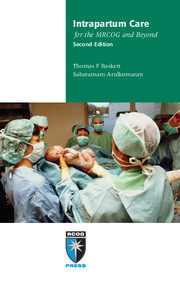Book contents
- Frontmatter
- Contents
- Preface
- Abbreviations
- 1 Improving intrapartum care
- 2 First stage of labour
- 3 Second stage of labour
- 4 Fetal surveillance in labour
- 5 Third stage of labour
- 6 Lower genital tract trauma
- 7 Induction of labour
- 8 Preterm labour and prelabour rupture of membranes
- 9 Assisted vaginal delivery
- 10 Shoulder dystocia
- 11 Breech vaginal delivery
- 12 Twin and triplet delivery
- 13 Caesarean section
- 14 Vaginal birth after caesarean section
- 15 Uterine rupture
- 16 Emergency obstetric hysterectomy
- 17 Cord prolapse
- 18 Antepartum haemorrhage
- 19 Postpartum haemorrhage
- 20 Acute uterine inversion
- 21 Amniotic fluid embolism
- 22 Disseminated intravascular coagulation
- 23 Acute tocolysis
- 24 Severe pre-eclampsia and eclampsia
- 25 Neonatal resuscitation
- 26 Perinatal loss: management of late fetal death and stillbirth
- Index
23 - Acute tocolysis
Published online by Cambridge University Press: 05 July 2014
- Frontmatter
- Contents
- Preface
- Abbreviations
- 1 Improving intrapartum care
- 2 First stage of labour
- 3 Second stage of labour
- 4 Fetal surveillance in labour
- 5 Third stage of labour
- 6 Lower genital tract trauma
- 7 Induction of labour
- 8 Preterm labour and prelabour rupture of membranes
- 9 Assisted vaginal delivery
- 10 Shoulder dystocia
- 11 Breech vaginal delivery
- 12 Twin and triplet delivery
- 13 Caesarean section
- 14 Vaginal birth after caesarean section
- 15 Uterine rupture
- 16 Emergency obstetric hysterectomy
- 17 Cord prolapse
- 18 Antepartum haemorrhage
- 19 Postpartum haemorrhage
- 20 Acute uterine inversion
- 21 Amniotic fluid embolism
- 22 Disseminated intravascular coagulation
- 23 Acute tocolysis
- 24 Severe pre-eclampsia and eclampsia
- 25 Neonatal resuscitation
- 26 Perinatal loss: management of late fetal death and stillbirth
- Index
Summary
As noted in other chapters, there are a number of conditions in obstetrics in which prompt relaxation of the uterus is necessary. In the past this could be achieved only by the rapid induction of general anaesthesia using halogenated agents, with its attendant risks. The development of simply administered tocolytic drugs has reduced the need for this risky use of general anaesthesia.
When acute tocolysis is required, regional anaesthesia in the form of spinal or epidural block may be in place. Although these regional anaesthetics provide good analgesia, they have no tocolytic effect; hence, the administration of tocolytic drugs is necessary to achieve optimum uterine relaxation.
Indications
EXCESSIVE UTERINE ACTION IN LABOUR
Uterine hyperstimulation in labour is defined as more than five uterine con tractions in a 10-minute period (tachysystole) or contractions exceeding 2 minutes in duration (hypertonus). Although uterine hyper stimulation can occur in spontaneous labour, it is more likely in pathological conditions such as placental abruption. Uterine hyperstimulation is most often found in response to uterotonic drugs such as oxytocin and, more commonly, prostaglandins which are used for cervical ripening and induction of labour.
- Type
- Chapter
- Information
- Intrapartum Care for the MRCOG and Beyond , pp. 245 - 250Publisher: Cambridge University PressPrint publication year: 2011



